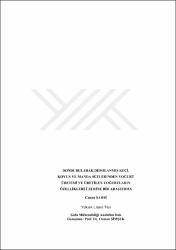| dc.contributor.advisor | Şimşek, Osman | |
| dc.contributor.author | Şahsi, Canan | |
| dc.date.accessioned | 2022-04-06T06:49:28Z | |
| dc.date.available | 2022-04-06T06:49:28Z | |
| dc.date.issued | 2020 | |
| dc.identifier.uri | https://tez.yok.gov.tr/UlusalTezMerkezi/TezGoster?key=_F5QEpayDXGqGZlp9XiFtCnVuVcIIxfkh4XxRY2nuc0JbW-1tapBkk3S56Nng-S8 | |
| dc.identifier.uri | https://hdl.handle.net/20.500.11776/4129 | |
| dc.description.abstract | Araştırmada, laktasyon dönemleri belirli mevsimlerde olan keçi, koyun ve mandaların sütlerinden tüm yıl yararlanılabilmesi ve süt ürünlerine işlenebilmesi için bu sütlerin dondurularak depolanıp belirlenen günlerde çözündürülerek yoğurt üretilmesi ve elde edilen yoğurtların fiziksel, kimyasal ve duyusal özelliklerinin belirlenmesi amaçlanmıştır. Bu amaç doğrultusunda pastörize keçi, koyun ve manda sütleri dondurulmuş ve üç ay boyunca -20 °C'de depolanmıştır. Depolamanın 0.,1., 2., ve 3. aylarında, dondurulan sütler çözündürülerek set tipi yoğurt üretimiyle yoğurt yapılmış ve depolanan yoğurtların 1., 7. ve 14. günlerinde fiziksel, kimyasal ve duyusal özellikleri incelenmiştir. İncelemeler sonucunda; sütlerin dondurularak depolanmasının yoğurt örneklerinde kuru madde, yağ, protein, titrasyon asitliği ve pH değerlerinde istatistiksel olarak (p>0,05) önemli bir değişime neden olmadığı belirlenmiştir. Yoğurtların 14 günlük depolama süresi boyunca titrasyon asitliğinde artış, pH değerlerinde azalış meydana gelmiştir. En düşük serum ayrılması miktarını ve en yüksek su tutma kapasitesini koyun yoğurdu gösterirken, keçi yoğurdu en düşük su tutma kapasitesini ve en yüksek serum ayrılması miktarını göstermiştir. Depolama süresi boyunca üç yoğurt türünde de serum ayrılması miktarı artmış, su tutma kapasitesi azalmıştır. Yoğurtlarda fenolik madde miktarı sütün dondurulmasına bağlı olarak azalış göstermiş ve bu azalış istatistiksel olarak (p<0,05) önemli bulunmuştur. Renk değerlerinde de değişimler meydana gelmiş L* değerleri dondurularak depolama sırasında önemli (p<0,05) ölçüde azalmıştır. En iyi tekstürel özellikleri manda yoğurdu göstermiş, onu koyun ve ardından keçi yoğurdu takip etmiştir. Duyusal analizlerde panelistler tarafından tüm örneklerin incelenen parametreleri beğenilmiş, keçi yoğurdu iyiye yakın, koyun ve manda yoğurdu ise iyinin üzerinde değerler almıştır. Ayrıca yoğurdun hammadesinin farklı sütlerden olması yoğurtların fiziksel, kimyasal, duyusal özelliklerinde farklılıklar meydana getirdiği görülmüştür. En iyi özellikleri koyun yoğurdu gösterirken, en düşük değerleri keçi yoğurdu almıştır. | en_US |
| dc.description.abstract | In this research, it was aimed to determine the physical, chemical and sensory properties of yogurt made from frozen and freeze-storage the milk of goat, sheep and buffalo. For this purpose, pasteurized goat, sheep and buffalo milk were frozen and stored at -20 °C for three months. In the 0., 1., 2., and 3. months of storage, frozen milk was thawed and yoghurt was made with set type yogurt production, and the physical, chemical and sensory properties of the stored yoghurts were examined on the 1st, 7th and 14th days. According to the results obtained it has been determined that freezing and storing of milk does not cause a statistically significant change (p>0.05) in dry matter, fat, protein, titration acidity and pH values in yoghurt samples. An increase in titration acidity and a decrease in pH values occurred, during the 14 day storage period of yoghurt. Sheep yogurt showed the lowest amount of whey separation and highest water holding capacity, while goat yogurt showed the lowest water holding capacity and highest whey separation. During the storage period, the amount of whey separation increased and water holding capacity decreased in all three yoghurt types. The amount of phenolic content in yoghurts decreased due to the freezing of milk and this decrease was found statistically (p <0.05). Changes in color values occurred and L* values decreased significantly (p<0.05) during freeze storage. The best textural properties showed buffalo yogurt, followed by sheep yogurt and then goat yogurt. In sensory evaluations the parameters of all samples examined by panelists were liked and goat yogurt was close to good, sheep and buffalo yogurt were more than good. In addition, it was observed that the raw material of yogurt was made of different milk, and the physical, chemical and sensory properties of yoghurts produced differences. Sheep yogurt showed the best features, while goat yogurt received the lowest values. | en_US |
| dc.language.iso | tur | en_US |
| dc.publisher | Tekirdağ Namık Kemal Üniversitesi | en_US |
| dc.rights | info:eu-repo/semantics/openAccess | en_US |
| dc.subject | Gıda Mühendisliği | en_US |
| dc.subject | Food Engineering | en_US |
| dc.subject | Yoğurt | en_US |
| dc.subject | dondurulmuş süt | en_US |
| dc.subject | keçi yoğurdu | en_US |
| dc.subject | koyun yoğurdu | en_US |
| dc.subject | manda yoğurdu | en_US |
| dc.subject | Yogurt | en_US |
| dc.subject | frozen milk | en_US |
| dc.subject | goat yogurt | en_US |
| dc.subject | sheep yogurt | en_US |
| dc.subject | buffalo yogurt | en_US |
| dc.title | Dondurularak depolanmış keçi, koyun ve manda sütlerinden yoğurt üretimi ve üretilen yoğurtların özellikleri üzerine bir araştırma | en_US |
| dc.title.alternative | A study on yoghurt production from frozen stored goat, sheep and buffalo milk and properties of yoghurt | en_US |
| dc.type | masterThesis | en_US |
| dc.department | Enstitüler, Fen Bilimleri Enstitüsü, Gıda Mühendisliği Ana Bilim Dalı | en_US |
| dc.identifier.startpage | 1 | en_US |
| dc.identifier.endpage | 121 | en_US |
| dc.institutionauthor | Şahsi, Canan | |
| dc.relation.publicationcategory | Tez | en_US |
| dc.identifier.yoktezid | 630339 | en_US |



















